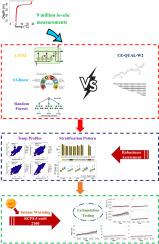当前位置:
X-MOL 学术
›
J. Clean. Prod.
›
论文详情
Our official English website, www.x-mol.net, welcomes your feedback! (Note: you will need to create a separate account there.)
Climate warming effects in stratified reservoirs: Thorough assessment for opportunities and limits of machine learning techniques versus process-based models in thermal structure projections
Journal of Cleaner Production ( IF 11.1 ) Pub Date : 2024-04-24 , DOI: 10.1016/j.jclepro.2024.142347 Chenxi Mi , Ammanuel B. Tilahun , Martina Flörke , Hans H. Dürr , Karsten Rinke
Journal of Cleaner Production ( IF 11.1 ) Pub Date : 2024-04-24 , DOI: 10.1016/j.jclepro.2024.142347 Chenxi Mi , Ammanuel B. Tilahun , Martina Flörke , Hans H. Dürr , Karsten Rinke

|
It is nowadays a hot topic to apply machine learning (ML) algorithms to illustrate water temperature dynamics in lentic waters. Due to the limited amount of temperature measurements from traditional sampling programmes, most of the related studies, however, restricted their analysis within the surface and rarely checked the results for whole depth profiles. Moreover, capability of such methods in projecting thermal dynamics under future climate conditions is even less illustrated. To fill the gap, we collected an unparalleled huge database including 9 million water temperature measurements, from 2013 to 2022, in Rappbode Reservoir, Germany as well as the corresponding climatic and hydrological observations, to train three commonly used ML models (Random Forest, XGBoost, and Long Short-Term Memory) and comprehensively evaluate their performance in reproducing thremal structure within the whole water column. We also systemically compared such simulation results with a well-established process-driven model (CE-QUAL-W2). Going beyond a pure reproduction of observatiosn, we further evaluated the ability of CE-QUAL-W2 and ML models in projecting thermal dynamics under RCP8.5 climate scenario up to 2100. Our results suggested three ML methods yielded high accuracy in capturing water temperature dynamics from the surface (epilimnion) to bottom (hypolimnion), and also satisfactorily reproduced temporal development of the stratification pattern, with the results corresponding well with those from CE-QUAL-W2. By contrast, the projections by ML models were rather insensitive to future climate warming under RCP8.5 comparing with those by CE-QUAL-W2, pointing to an important risk whenever ML-based models are extrapolated beyond their training data range. Supported by millions of measurements, our research clearly illustrated the opportunities (limits) of ML models in projecting thermal dynamics in deep waters, and the conclusion also provides key guidance for scientists to select the appropriate tools in projecting water temperature, and other environmental factors, under changing climate.
中文翻译:

分层水库的气候变暖效应:全面评估机器学习技术与热结构预测中基于过程的模型的机会和局限性
应用机器学习(ML)算法来说明静水中的水温动态是当今的热门话题。然而,由于传统采样程序的温度测量数量有限,大多数相关研究都将其分析限制在地表范围内,很少检查整个深度剖面的结果。此外,此类方法在未来气候条件下预测热动力学的能力甚至更少得到说明。为了填补这一空白,我们收集了一个无与伦比的庞大数据库,包括 2013 年至 2022 年德国拉普博德水库 900 万次水温测量数据以及相应的气候和水文观测数据,来训练三种常用的 ML 模型(随机森林、XGBoost) ,和长短期记忆)并综合评估它们在整个水柱内再现阈值结构的性能。我们还将此类模拟结果与完善的流程驱动模型 (CE-QUAL-W2) 进行了系统比较。除了纯粹的观测再现之外,我们还进一步评估了 CE-QUAL-W2 和 ML 模型在截至 2100 年的 RCP8.5 气候情景下预测热动态的能力。我们的结果表明,三种 ML 方法在捕获水温动态方面具有很高的准确性从表面(epilimnion)到底部(hypolimnion),并且还令人满意地再现了分层模式的时间发展,其结果与CE-QUAL-W2的结果很好地对应。相比之下,与 CE-QUAL-W2 相比,ML 模型的预测对 RCP8.5 下的未来气候变暖相当不敏感,这表明每当基于 ML 的模型外推超出其训练数据范围时,就会存在重要风险。在数百万次测量的支持下,我们的研究清楚地说明了机器学习模型在预测深海热动力学方面的机会(局限性),结论还为科学家选择合适的工具来预测水温和其他环境因素提供了关键指导,在气候变化的情况下。
更新日期:2024-04-24
中文翻译:

分层水库的气候变暖效应:全面评估机器学习技术与热结构预测中基于过程的模型的机会和局限性
应用机器学习(ML)算法来说明静水中的水温动态是当今的热门话题。然而,由于传统采样程序的温度测量数量有限,大多数相关研究都将其分析限制在地表范围内,很少检查整个深度剖面的结果。此外,此类方法在未来气候条件下预测热动力学的能力甚至更少得到说明。为了填补这一空白,我们收集了一个无与伦比的庞大数据库,包括 2013 年至 2022 年德国拉普博德水库 900 万次水温测量数据以及相应的气候和水文观测数据,来训练三种常用的 ML 模型(随机森林、XGBoost) ,和长短期记忆)并综合评估它们在整个水柱内再现阈值结构的性能。我们还将此类模拟结果与完善的流程驱动模型 (CE-QUAL-W2) 进行了系统比较。除了纯粹的观测再现之外,我们还进一步评估了 CE-QUAL-W2 和 ML 模型在截至 2100 年的 RCP8.5 气候情景下预测热动态的能力。我们的结果表明,三种 ML 方法在捕获水温动态方面具有很高的准确性从表面(epilimnion)到底部(hypolimnion),并且还令人满意地再现了分层模式的时间发展,其结果与CE-QUAL-W2的结果很好地对应。相比之下,与 CE-QUAL-W2 相比,ML 模型的预测对 RCP8.5 下的未来气候变暖相当不敏感,这表明每当基于 ML 的模型外推超出其训练数据范围时,就会存在重要风险。在数百万次测量的支持下,我们的研究清楚地说明了机器学习模型在预测深海热动力学方面的机会(局限性),结论还为科学家选择合适的工具来预测水温和其他环境因素提供了关键指导,在气候变化的情况下。



























 京公网安备 11010802027423号
京公网安备 11010802027423号